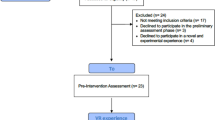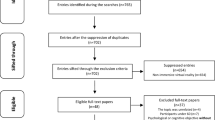Abstract
The purpose of this case study was to examine the physiological and psychosocial effects of an immersive virtual reality (VR) system in a female, young adult with physical disabilities. Mixed-methods. University, City, State, USA. The current study consisted of six sessions over a span of three weeks, with each session lasting approximately 45 min. Physiological factors (upper body mobility, heart rate variability) were assessed via a hand use questionnaire and a heart rate monitor, while psychosocial factors (e.g. positive mood) were assessed through post-session debriefing discussions with the participant. All measures were completed at each of the six VR sessions, with the exception of the hand use questionnaire, which was administered at baseline, and post-intervention. The VR programs selected were specifically chosen to engage upper body and arm movements. Descriptive analyses and coding of interviews were conducted to examine changes throughout the study sessions. The participant reported an increase in hand mobility and psychosocial well-being, such as improvement in mood, as a result of her participation in the VR sessions. The results of this preliminary case study suggest that the use of movement-specific VR programs may be beneficial to individuals with physical disabilities, although future research in larger samples is warranted.


Similar content being viewed by others
References
Adams, K., & Cook, A. (2014). Access to hands-on mathematics measurement activities using robots controlled via speech generating devices: Three case studies. Disability and Rehabilitation: Assistive Technology, 9(4), 286–298. https://doi.org/10.3109/17483107.2013.825928.
Amer, A., Eliasson, A. C., Peny-Dahlstrand, M., & Hermansson, L. (2015). Validity and test-retest reliability of Children’s hand-use experience questionnaire in children with unilateral cerebral palsy. Developmental Medicine and Child Neurology, 58, 743–749.
Benromano, T., Pick, C. G., Merick, J., & Defrin, R. (2017). Physiological and behavioral responses to calibrated noxious stimuli among individuals with cerebral palsy and intellectual disability. Pain Medicine, 18(3), 441–453. https://doi.org/10.1093/pm/pnw155.
Chalmers, J. A., Quintana, D. S., Abbott, M. J., & Kemp, A. H. (2014). Anxiety disorders are associated with reduced heart rate variability: A meta-analysis. Frontiers in Psychiatry, 5, 80. https://doi.org/10.3389/fpsyt.2014.00080.
Chen, Y. P., Lee, S. Y., & Howard, A. M. (2014). Effect of virtual reality on upper extremity function in children with cerebral palsy: A meta-analysis. Pediatric Physical Therapy, 26(3), 289–300. https://doi.org/10.1097/PEP.0000000000000046.
Christensen, D., Van Naarden Braun, K., Doernberg, N. S., Maenner, M. J., Arneson, C. L., Durkin, M. S., et al. (2014). Prevalence of cerebral palsy, co-occurring autism spectrum disorders, and motor functioning – Austin and developmental disabilities monitoring network, USA, 2008. Developmental Medicine and Child Neurology, 56(1), 59–65. https://doi.org/10.1111/dmcn.12268.
Cohen-Holzer, M., Sorek, G., Kerem, J., & Katz-Leurer, M. (2017). The impact of combined constraint-induced and bimanual arm training program on the perceived hand-use experience of children with unilateral cerebral palsy. Developmental Neurorehabilitation, 20(6), 355–360. https://doi.org/10.1080/17518423.2016.1238017.
De Los Reyes-Guzmán, A., Pérez-Nombela, S., Dimbwadyo-Terrer, I., Torricelli, D., & Gil-Agudo, A. (2013). Functional upper limb evaluation of activities of daily living in people with neurological disorders. In J. B. Giroux & C. Vallee (Eds.), Activities of daily living: Performance, impact on life quality and assistance (pp. 55–75). New York: Nova Science Publishers, Inc..
Debuse, D., Gibb, C., & Chandler, C. (2009). Effects of hippotherapy on cerebral palsy from the user’s perspective: A qualitative study. Physiotherapy Therapy and Practice, 25(3), 174–192. https://doi.org/10.1080/09593980902776662.
Dickinson, H. O., Parkinson, K. N., Ravens-Sieberer, U., Schirripa, G., Thyen, U., Arnaud, C., et al. (2007). Self-reported quality of life of 8-12-year-old children with cerebral palsy: A cross-sectional European study. Lancet, 369, 2171–2178.
Do, J. H., Yoo, E. Y., Jung, M. Y., & Park, H. Y. (2016). The effects of virtual reality-based bilateral arm training on hemiplegic children's upper limb motor skills. Neurorehabilitation, 38(2), 115–127. https://doi.org/10.3233/NRE-16130.
Hamilton, I., (2016). Watch a kid in the hospital report less pain after using Google’s ‘Tilt Brush.’ Retrieved from http://uploadvr.com/watch-kids-hospital-reduce-pain-using-htc-vive/
Jenks, K., van Lieshout, E., & de Moor, J. (2012). Cognitive correlates of mathematical achievement in children with cerebral palsy and typically developing children. British Journal of Educational Psychology, 82(1), 120–135. https://doi.org/10.1111/j.2044-8279.2011.02034.
Kok, B. E., Coffey, K. A., Cohn, M. A., Catalino, L. I., Vacharkulksemsuk, T., Algoe, S. B., & Fredrickson, B. L. (2013). How positive emotions build physical health: Perceived positive social connections account for the upward spiral between positive emotions and vagal tone. Psychological Science, 24(7), 1123–1132. https://doi.org/10.1177/0956797612470827.
Kuhlen, T., & Dohle, C. (1995). Virtual reality for physically disabled people. Computers in Biology and Medicine, 25(2), 205–211. https://doi.org/10.1016/0010-4825(94)00039-S.
Lagunju, I. A., Okereke, J., Adebayo, A., & Eni-Olorunda, T. (2010). Neurocognitive and sensory impairments in cerebral palsy. Journal of Pediatric Neurology, 8(4), 385–390. https://doi.org/10.3233/JPN-2010-0419.
Lehrer, P. M., & Gevirtz, R. (2014). Heart rate variability biofeedback: How and why does it work? Frontiers in Psychology, 5, 756.
Li, W., Lam-Damji, S., Chau, T., & Fehlings, D. (2009). The development of a home-based virtual reality therapy system to promote upper extremity movement for children with hemiplegic cerebral palsy. Technology & Disability, 21(3), 107–113. https://doi.org/10.3233/TAD-2009-0277.
McDonald, E. T., & Chance, B. (1964). Cerebral palsy. Englewood Cliffs: Prentice-Hall, Inc..
Ravi, D., Kumar, N., & Singhi, P. (2017). Effectiveness of virtual reality rehabilitation for children and adolescents with cerebral palsy: An updated evidence-based systematic review. Physiotherapy, 103(3), 245–258.
Sharar, S. R., Miller, W., Teeley, A., Soltani, M., Hoffman, H. G., Jensen, M. P., & Patterson, D. R. (2008). Applications of virtual reality for pain management in burn-injured patients. Expert Review of Neurotherapeutics, 8(11), 1667–1674. https://doi.org/10.1586/14737175.8.11.1667.
Sköld, A., Hermansson, L. N., Krumlinde-Sundholm, L., & Eliasson, A. C. (2011). Development and evidence of validity for the Children’s Hand-use Experience Questionnaire (CHEQ). Developmental Medicine & Child Neurology, 53(5), 436–442. https://doi.org/10.1111/j.1469-8749.2010.03896.x.
Slobounov, S. M., Ray, W., Johnson, B., Slobounov, E., & Newell, K. M. (2015). Modulation of cortical activity in 2D versus 3D virtual reality environments: An EEG study. International Journal of Psychophysiology, 95(3), 254–260.
University of Chicago Consortium on School Research (n.d.) A primer on rasch analysis. Retrieved from https://consortium.uchicago.edu/downloads/9585ccsr_rasch_analysis_primer.pdf
Washam, V. (1973). The one hander’s book. New York: The John Day Company.
Yeh, A. M., Wren, A., & Golianu, B. (2017). Mind-body interventions for pediatric inflammatory bowel disease. Children (Basel, Switzerland), 4(4). https://doi.org/10.3390/children4040022.
Author information
Authors and Affiliations
Corresponding author
Ethics declarations
Ethical Approval
All procedures performed in studies involving human participants were in accordance with the ethical standards of the institutional and/or national research committee and with the 1964 Helsinki declaration and its later amendments or comparable ethical standards.
Informed Consent
Informed consent was obtained from all individual participants included in the study.
Conflict of Interest
The authors declare no conflict of interest.
Rights and permissions
About this article
Cite this article
Fralish, B., Nickels, M. & Garcia, J. Improved Physiology and Psychosocial Well-Being for Individuals with Physical Disabilities through Virtual Reality Immersion: a Case Study. J Dev Phys Disabil 30, 771–782 (2018). https://doi.org/10.1007/s10882-018-9618-9
Published:
Issue Date:
DOI: https://doi.org/10.1007/s10882-018-9618-9




